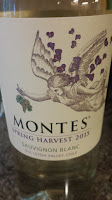 In 2016, International Carmenère Day (November 24th) fell on the American Thanksgiving holiday so Wines of Chile postponed a collaboration with Snooth until mid-December. During this Master Class, participants tasted through a large selection of Chilean (plus one Italian) Carmenère wines while learning about Chile's Central Valley wine region. The region is sub-divided into four smaller zones: Maipo Valley, Maule Valley, Curicó Valley, and Rapel Valley. The latter zone includes the famed Colchagua Valley - located on the foothills of the Andes and home to many of Chile's iconic wineries. Regarding exports to the United States, Carmenère is represented in about 30% of the blended wine, whereas as a single varietal it accounts for only 4% of U.S. imports. Here are the wines we sampled:
In 2016, International Carmenère Day (November 24th) fell on the American Thanksgiving holiday so Wines of Chile postponed a collaboration with Snooth until mid-December. During this Master Class, participants tasted through a large selection of Chilean (plus one Italian) Carmenère wines while learning about Chile's Central Valley wine region. The region is sub-divided into four smaller zones: Maipo Valley, Maule Valley, Curicó Valley, and Rapel Valley. The latter zone includes the famed Colchagua Valley - located on the foothills of the Andes and home to many of Chile's iconic wineries. Regarding exports to the United States, Carmenère is represented in about 30% of the blended wine, whereas as a single varietal it accounts for only 4% of U.S. imports. Here are the wines we sampled:Cono Sur Bicicleta Carmenere Central Valley Chile 2015 ($9) 85% Carmenere and 15% other reds gives this wine a pepper, leathery nose, followed by a light bodied middle with easy yet noticeable tannin. What a bargain at this price.
Casillero del Diablo Carmenere Reserva Central Valley Chile 2015 ($10) The "Cellar Devil" starts with bell pepper and red fruit but fell a little flat on the finish.
Casas del Bosque Carmenere Reserva Rapel Valley 2015 ($11) Aged ten months in oak, this wine exudes big candied fruit, bright acids, a spicy finish, and lingering easy tannins. Another remarkable QPR.
Concha y Toro Serie Riberas Carmenere Gran Reserva Peumo 2014 ($14) This wine included 5% Cabernet Sauvignon and is part of the winery's Riverside vineyards from the Peumo Vineyard. It is a winner with it's rounded and herbaceous character and long spicy finish. Will become a household everyday wine.
Los Vascos Carmenere Grande Reserve Colchagua Valley 2013 ($18) Aged 12 months in French oak barrels, this wine is herbaceous and vege (peppers) with darker fruit; then a very smooth tail.
Apaltagua Red Blend Colchagua Valley Envero 2014 ($18) Comprised of 90% Carmenère and 10% Cabernet Sauvignon from 60+ year old vines located in the Colchagua Valley's Apalta region. Various oak regiments don't inhibit a lighter fruit profile and freshness. The Carmenère shines through.
Casa Silva Los Lingues Vineyard Carmenere Colchagua Valley 2014 ($20) Harvested from vines graowing at the foothills of the Andes at 1,100 feet, this is an elegant and well rounded wine. The 70 degree diurnal temperature variation also helps the grapes retain acidity adding brightness. Very nice.
Colli Berici Oratorio di San Lorenzo Carmenere Riserva 2012 ($33) The 100% Italian Carmenere is from the Oratorio di San Lorenzo in Località San Germano dei Berici (Vicenza) which can now be labeled Carmenere Riserva D.O.C.. The wine matures for 18 months in oak and then another year in the bottle before release. This is a fantastic wine with dried fruit, dirt, then finishes with dark chocolate and structured tannins.
Montes Alpha Carmenere Colchagua Valley 2013 ($25) The flagship composed of 90% Carmenère and 10% Cabernet Sauvignon and harvested from dry farmed vines in Apalta and Marchigüe. This wine has everything, sharp aromas, intense fruit followed by layers of texture and refreshing acidity and silky smooth tannins. Update 1/2/2017: Initially I had written "Just wish it fit more in line with my price range" when I thought the price was $52. In reality the correct SRP is $25.
Viña Maquis Viola Carmenere Colchagua Valley 2010 ($55) Includes 15% Cabernet Franc and is smokey throughout; which provides an interesting aspect. The grapes were harvested for their concentration (the smaller the size, the better) and aged 14 months in French Oak after fermentation. Once the smoke profile subsides, a silky black fruit character emerges with smooth tannins. The most intriguing of the bunch.
Purple Angel Colchagua Valley 2013 ($67) The 92% Carmenère and 8% Petit Verdot were harvest from Marchigüe and Apalta and aged 18 months in new French Oak after fermentation. Don't let that fool you into thinking this wine is overly oaked. The dark fruit shines worth in both texture and brightness. And the finish is oh so smooth. Recommended for those with a higher wine budget.


